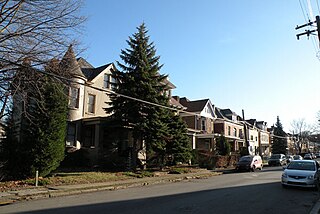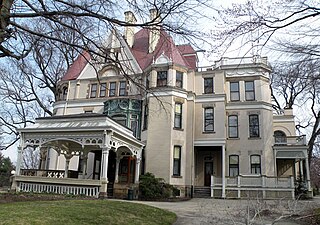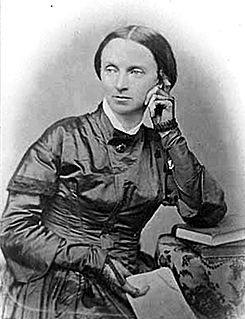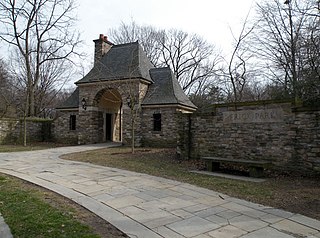
Homestead is a borough in Allegheny County, Pennsylvania, USA, in the Monongahela River valley 7 miles (11 km) southeast of downtown Pittsburgh and directly across the river from the city limit line. The borough is known for the Homestead Strike of 1892, an important event in the history of labor relations in the United States. The population of Homestead was 2,884 at the 2020 census.

Munhall is a borough in Allegheny County, Pennsylvania, on the west bank of the Monongahela River, 8 miles (13 km) south of the confluence of the Monongahela and the Allegheny rivers where the Ohio River begins. It abuts the borough of Homestead.

Swissvale is a borough in Allegheny County, Pennsylvania, 9 miles (14 km) east of downtown Pittsburgh. Named for a farmstead owned by James Swisshelm, during the industrial age it was the site of the Union Switch and Signal Company of George Westinghouse. The population was 8,983 at the 2010 census. In 1940, 15,919 people lived there.

Squirrel Hill is a residential neighborhood in the East End of Pittsburgh, Pennsylvania, United States. The city officially divides it into two neighborhoods, Squirrel Hill North and Squirrel Hill South, but it is almost universally treated as a single neighborhood.

Oakland is the academic and healthcare center of Pittsburgh and one of the city's major cultural centers. The neighborhood is home to three universities, museums, and hospitals, as well as an abundance of shopping, restaurants, and recreational activities. Oakland is home to the Schenley Farms National Historic District which encompasses two city designated historic districts: the mostly residential Schenley Farms Historic District and the predominantly institutional Oakland Civic Center Historic District. It is also home to the locally designated Oakland Square Historic District. The Pittsburgh Bureau of Fire has Fire Station No. 14 on McKee Place and Fire Station No. 10 on Allequippa Street in Oakland.

Schenley Park is a large municipal park located in Pittsburgh, Pennsylvania, between the neighborhoods of Oakland, Greenfield, and Squirrel Hill. It is also listed on the National Register of Historic Places as a historic district. In 2011, the park was named one of "America's Coolest City Parks" by Travel + Leisure.

Greenfield is a neighborhood in Pittsburgh, Pennsylvania, United States. It is represented on Pittsburgh City Council by Corey O'Connor.

Highland Park is a neighborhood in the northeastern part of Pittsburgh, Pennsylvania. Highland Park, the neighborhood, fully encompasses the park with the same name.

The Allegheny County Belt System color codes miscellaneous county roads to form a unique system of routes in Allegheny County, Pennsylvania, and around the city of Pittsburgh.

Point Breeze, or South Point Breeze, is a largely residential neighborhood in Pittsburgh, Pennsylvania, USA. The community was named after a tavern once located there.

Hays is a neighborhood in the 31st Ward of the east side of Pittsburgh, Pennsylvania. It is represented on the Pittsburgh City Council by the representative of District 5. It occupies ZIP codes 15227, 15207, and 15236. It is named after James H. Hays, who opened a coal-mining operation called Hays and Haberman Mines in 1828.

Regent Square is a neighborhood in the East End of Pittsburgh, Pennsylvania. According to its civic association, it "includes portions of the municipalities of Pittsburgh, Edgewood, Swissvale and Wilkinsburg". It is also the name of one of the 90 neighborhoods within the City of Pittsburgh's limits, which leads to some confusion among residents. In 2017, it was named the #1 neighborhood to live in Pittsburgh and the #17 best neighborhood in the United States by Niche.com.

Jane Grey Cannon Swisshelm was an American Radical Republican journalist, publisher, abolitionist, and women's rights advocate. She was one of America's first female journalists hired by Horace Greeley at his New York Tribune. She was active as a writer in Pittsburgh, Pennsylvania, and as a publisher and editor in St. Cloud, Minnesota, where she founded a string of newspapers and regularly wrote for them.

Frick Park is the largest municipal park in Pittsburgh, Pennsylvania, United States, covering 644 acres (1.006 sq mi). It is one of Pittsburgh's four historic large parks.

The Three Rivers Heritage Trail is an urban rail trail paralleling the riverbanks in Pittsburgh, Pennsylvania and Allegheny County for about 33 miles (53 km), often on both sides of the rivers, and offering views of the city. The trail is promoted and maintained in part by the 'Friends of the Riverfront'. Their stated mission is to increase awareness and engagement with the region's rivers and riverfronts through activities and stewardship, and to extend the water and land trails on the major rivers within Allegheny County.

Bellefield Boiler Plant, also known as "The Cloud Factory" from its nickname's use in Michael Chabon's 1988 debut novel The Mysteries of Pittsburgh, is a boiler plant located in Junction Hollow between the Carnegie Institute of Pittsburgh and Carnegie Mellon University in the Oakland district of Pittsburgh, Pennsylvania.

Longfellow, Alden & Harlow, of Boston, Massachusetts, and Pittsburgh, Pennsylvania, was the architectural firm of Alexander Wadsworth Longfellow Jr. (1854–1934), Frank Ellis Alden (1859–1908), and Alfred Branch Harlow (1857–1927). The firm, successors to H. H. Richardson, continued to provide structures in the Romanesque revival style established by Richardson that is often referred to as Richardsonian Romanesque.

Summerset at Frick Park is a residential development located in the Squirrel Hill and Swisshelm Park neighborhoods within the City of Pittsburgh and Allegheny County. This project is one of the nation's first brownfield sites to be remediated for residential purposes. The $250 million public-project began in 1997 and is the City of Pittsburgh's largest residential development since World War II. At completion, Summerset at Frick Park will have over 700 residences and its annual property tax revenue is anticipated to be in the range of $5.7 million to $6.3 million.

The Fern Hollow Bridge was a bridge in the East End of Pittsburgh, Pennsylvania that carried Forbes Avenue over a large ravine in Frick Park. The bridge opened in 1973 and collapsed on January 28, 2022. The bridge was west of the intersection of Forbes Avenue and South Braddock Avenue, connecting the Squirrel Hill neighborhood with the neighborhoods of Point Breeze and Regent Square.




















